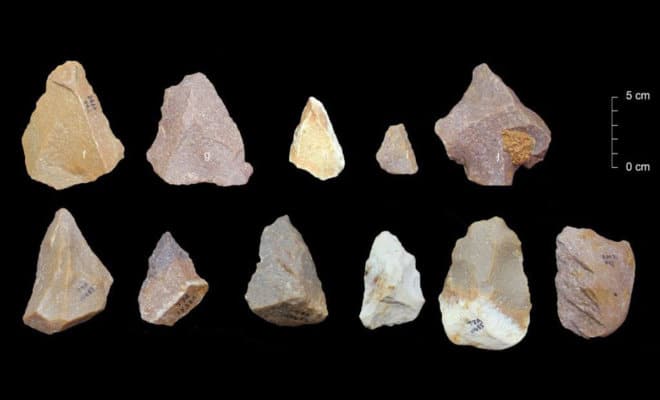India
Very Old Sophisticated Tools Found in India Puzzle Historians

Artifacts uncovered in the excavation at Attirampakkam.
Pjhoto: Sharma Centre for Heritage Education, India.
Starting roughly 385,000 years ago - long before modern humans are thought to have arrived in India - it appears that an advanced toolmaking culture was developing there.
Humanity’s origin story has gotten increasingly tangled in recent years: New discoveries suggest that Homo sapiens interacted and interbred with other species and ventured out of Africa in more than one wave. Researchers have compared the ancient world to J.R.R. Tolkien’s Middle Earth – but instead of hobbits, dwarves and elves, our planet had modern humans in Africa, Neanderthals in Europe, Homo erectusin Asia.
Now, a treasure trove of ancient stone tools suggest that humans’ circuitous path to modernity also wound through India.
In a paper published in the journal Nature, researchers described thousands of stone implements uncovered at Attirampakkam, an archaeological site in southern India. The tools span some million years of history, they say, and illustrate the evolution of big, blunt hand axes into finely sculpted stone points. Starting roughly 385,000 years ago – long before modern humans are thought to have arrived in India – it appears that an advanced toolmaking culture was developing there.
How did these techniques reach India so early? “That’s the multimillion-dollar question,” said archaeologist Shanti Pappu, founder of the Sharma Center for Heritage Education and a co-author of the report.
No remains were found alongside the Indian tools, meaning it’s impossible to determine whether the tools were produced by modern humans or one of our hominin cousins. If they were produced by members of our species, it would significantly shift the timeline of human evolution. But that’s a big “if,” Pappu acknowledged.
At the very least, she said, the discovery suggests “complex interactions” between the mystery hominins in India and their relatives around the globe.
“It shows that simple linear narratives of dispersal only at certain time periods is incorrect,” Pappu said.
Modern humans evolved in Africa, and the oldest known bones that could feasibly belong to our species were found in a Moroccan cave and dated to 300,000 years ago. The recent discovery of human fossils in an Israeli cave suggests we may have ventured into other continents as early as 194,000 years ago.
Upon leaving Africa, Homo sapiens would have encountered an array of distant relatives. Paleoanthropologists believe the first hominins left Africa about 1.7 million years ago, though there’s some dispute about what species those early migrants belonged to
With so few fossils available, reconstructing the story of human evolution and migration is a bit like trying to solve a jigsaw puzzle when you have just a handful of middle pieces and no edges or corners. Often, scientists must trace the movements of our ancestors through the stone tools we created.
The first hominins to leave Africa – whoever they were – carried with them oval- and pear-shaped hand axes used to pound and scrape food – a technology called Acheulean. The oldest tools found at Attirampakkam, which are more than 1 million years old, were crafted in this tradition.
But in a second batch of implements uncovered from a rock layer that spans 385,000 to 172,000 years ago (plus or minus roughly 50,000 years on either end), those heavy hand axes give way to smaller, more sophisticated points. One of the points even appears to have a groove that would allow it to be affixed to some kind of projectile, like a spear.
This kind of technology has long been associated with Neanderthals and Homo sapiens in Europe, the Middle East and Africa, and it wasn’t thought to have arrived in India until humans reached south Asia about 100,000 years ago. Known as Levallois, this technique is associated with significant advances in human cognition, because such tools can’t be crafted without the ability to think abstractly and plan ahead.
Alison Brooks, a paleoanthropologist at George Washington University, said she’s not convinced that the smaller tools described by Pappu and her colleagues are true Levallois points.
“It’s still basically a single point in a giant continent,” she added – more discoveries are required to give context to this find.
That’s what Pappu hopes for too. She noted that relatively few paleontology resources have been invested in India. The tools collected at Attirampakkam are among the first discoveries from India for which scientists even have a date.
“We hope this will be a jumping-off point for a new look at regions like India,” she said. “They also have a story to tell.”
